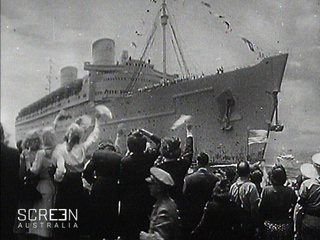Free for educational use
Immigration – Fill it or Lose It
Year of production - 1992
Duration - 4min 1sec
Tags - diversity, immigration, migrants, racism, refugees, White Australia Policy, see all tags
On this Page

How to Download the Video Clip
To download a free copy of this Video Clip choose from the options below. These require the free Quicktime Player.
![]() Premium MP4 fillit_pr.mp4 (29.6MB).
Premium MP4 fillit_pr.mp4 (29.6MB).
![]() Broadband MP4 fillit_bb.mp4 (14.0MB), suitable for iPods and computer downloads.
Broadband MP4 fillit_bb.mp4 (14.0MB), suitable for iPods and computer downloads.
Immigration – Fill It or Lose It is an excerpt from the documentary Admission Impossible (54 mins) produced in 1992.
Admission Impossible
For much of the 20th century, successive Australian governments pursued a policy of deporting and barring entry to any race of people they considered undesirable. This was known as the White Australia policy. Admission Impossible is the true story of the behind-the-scenes political forces and the propaganda campaigns that attempted to populate Australia with “pure white” migrants.
A Film Australia National Interest Program. Produced with the assistance of the Australian Broadcasting Corporation.
Outcomes
5.1 explains social, political and cultural developments and events and evaluates their impact on Australian life
5.3 explains the changing rights and freedoms of migrants in Australia
5.7 explains different contexts, perspectives and interpretations of the past.
Inquiry Question
How have the rights and freedoms of migrants in Australia changed during the post-war period?
Students learn about
- the changing patterns of migration 1945–2000
In the aftermath of World War 2 and invasion fears the Australian Labor Party created an Immigration portfolio and began to encourage migration to Australia from post-war Britain and Europe. While the official policy was still based on the 1902 Restricted Immigration Act, known officially among Immigration bureaucrats as the ‘Non-European’ policy, the continuing demand for labour in an expanding economy eventually made changes to the official policy inevitable.
In the 1960s the international coverage of the USA civil rights movement began to challenge many long held prejudices. In the 1970s the Vietnam War and the subsequent arrival of ‘boat people’ made changes to Immigration policy almost essential.
The final chapter in this sad story of prejudice and discrimination came with the reforms of the Whitlam Labor Government in 1973.
- Note-making – while watching clip:
- Note the year of Curtin’s speech.
- Note the sentiments of his speech.
- Note the problem that arose. Solution?
- Note details of the Asian refugees.
- Note the contribution of the Asian refugees to Australia’s war effort.
- Note how Asian refugees were affected by new legislation.
- Note details of Caldwell’s speech. Implications?
- Research
- Why did Australia begin to accept non-British migrants?
- When did Australia begin to accept migrants from countries which were not ‘white’?
- Conduct a survey of class members to find when families came to Australia and from where. (Be aware this can be a sensitive exercise.)
- Reporting
- Write a report on the Immigration Restriction Act of 1901.
- Construct a timeline that illustrates the steps by which Australia’s immigration policy has changed. Plot the class survey results on this timeline.
- Assess the success of the post-World War 2 migration scheme(s).


